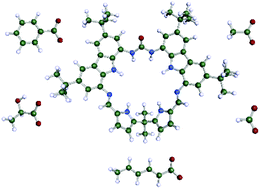Macrocyclic versus open-chain carbazole receptors for carboxylate binding†
Abstract
The anion recognition properties of six synthetic acyclic and macrocyclic carbazole-based receptors have been studied by 1H-NMR as well as with COSMO-RS calculations towards acetate, benzoate, lactate, sorbate and formate. The receptors differed by the number and geometry of hydrogen-bond donor (HBD) sites, the nature and length of the linker(s) between the HBD sites and the cyclic or non-cyclic nature. The binding ability of the receptors is strongly influenced by the structure and steric variables of the receptors and anions. It was found that when urea was replaced with the flexible diglycolyl as the connecting linker between carbazole subunits, the carboxylate binding affinity of the receptor decreased significantly. The effects of the receptors’ structure on anion binding have been investigated and several intriguing cases have been identified and analysed. The current findings shed light on carboxylate anion binding and contribute to the systematic synthesis of receptors with beneficial functional selectivity for carboxylate anions.

- This article is part of the themed collection: The Supramolecular Chemistry of Anions


 Please wait while we load your content...
Please wait while we load your content...